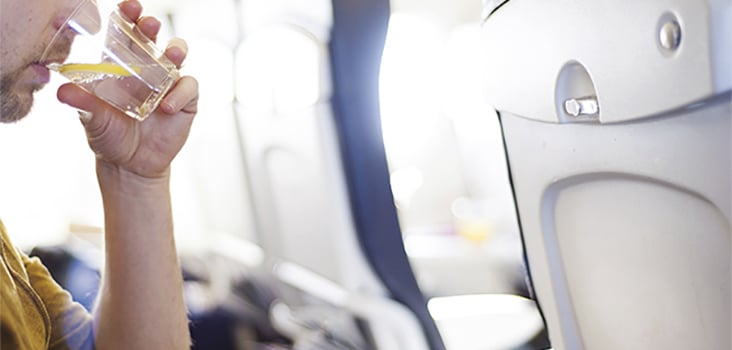
Preparing for Air Travel When You Have a Chronic Illness, Part 2
In continuation of Preparing for Air Travel When You Have a Chronic Illness, here are potential health risks of traveling by air, and measures you can take to combat those risks.
Jet Lag
Jet lag is a temporary sleep disorder that occurs in air travelers particularly after flying three (3) or more time zones. Our brain’s inner clock needs time to reset our sleep-wake cycle at the new destination. The internal drive for sleep is regulated by secretion of melatonin in our brain and its synthesis and release is stimulated by darkness and suppressed by light.
As a result, eastward travel (earlier darkness) is associated with difficulty falling asleep at the destination bedtime and difficulty awakening in the morning. Westward travel (delayed nightfall) is associated with early evening sleepiness and predawn awakening at the destination. Traveling eastward and crossing more time zones increases the time to adaptation. Westward travel generally requires fewer days to adjust than eastward travel.
Symptoms, Prevention, and Treatment
Because jet lag often results in delays in sleep onset, early awakening or sleeping for short time intervals; fatigue and poor performance during the day time is common. Headache, irritability, inability to concentrate, stomach upset and disordered moods are frequent. To minimize jet lag get plenty of exercise, and eat a healthy diet. Break up long flights with a stop-over if possible.
- Before eastward travel, begin resetting the body clock by going to sleep 1 to 2 hours earlier for several days. Shifting mealtimes earlier can help as well. Because bright sunlight resets our internal clocks forward, seek exposure to sunlight in the morning if traveling eastward to improve earlier sleep onset.
- Before westward travel, delay going to sleep 1 to 2 hours for a few days before travel. Shifting meal times later can help as well. Because bright sunlight resets our internal clocks forward, seek exposure to bright light in the evening if traveling west, to promote delay in sleep onset.
Mobile phone apps such as Entrain and Jet Lag Rooster can help travelers calculate and follow a light/dark schedule. In addition, avoid alcohol, caffeine and large meals (all three can disrupt sleep schedules). If possible, sleep during long flights. Drink plenty of water to avoid dehydration and move around on the plane to improve mental and physical activity.
Upon arrival at your destination, eat meals at the local times. Limit naps to 20 minutes so they will not reset your internal clock. For lengths of stay more than two days, or more serious concerns with jet lag, your physician may be able to prescribe a medicine that can help initiate sleep if you do not have any contraindications to that medication.
Blood Clots and Prolonged Air Travel
Because prolonged sitting in cramped conditions can interfere with return of blood flow from the legs to the heart, prolonged air travel has been noted to increase the risk of blood clots in the deep veins of the leg. Fragments of blood clots in the legs can travel to the lungs and be life-threatening. The actual risk of a blood clot (thrombosis) in a deep vein of the leg (DVT) is very difficult to determine because they are uncommon in the healthy traveler and because most blood clots in the leg are asymptomatic.
Several studies suggest that 0.5% of air travelers whose flight duration was greater than 8 hours developed a DVT. The risk of a clot developing increases with duration of flight (>4-8 hours), height (<5 ft. 3 inches and >6 ft 3 inches). Leg room and seat edge pressure on the back of the knee are suspected to be risks factors.
However, the biggest risk factors to developing deep vein clotting during air travel is underlying disease and several other risk factors including the following:*
- Elderly, inactive individuals, or obesity
- Estrogen use
- Pregnancy and the postpartum period
- Active cancer
- Previous venous thromboembolism
- Serious medical illness (congestive heart failure or inflammatory bowel disease)
- Recent surgery, hospitalization or leg trauma
- Limited mobility
- Central venous catheterization
Symptoms and Prevention
Signs and symptoms of DVT include pain, swelling or tenderness of the calf and redness or discoloration of the overlying skin. If a blood clot travels to the lungs, a patient may develop unexplained shortness of breath, chest pain, cough, or fainting. If these symptoms develop within 48 hours to 6-8 weeks of air travel, the traveler is advised to seek urgent medical care. Do not ignore these symptoms as blood clots to the lungs may occasionally be fatal.
Prevention of DVT and VTE for long distance travelers:
- Frequent walking in the aisle when possible
- Calf muscle exercises
- Aisle seating where possible
Prevention of DVT and VTE for long distance travelers with increased risk of DVT/VTE:
- Consult your physician
- Properly fitted graduated compression socks
- Anticoagulation only in particular high risk cases per the advice of your clinician
- Frequent ambulation, calf muscle exercises and aisle seating where possible.
We wish you safe and pleasant travels!
*SEEK CONSULTATION WITH YOUR HEALTH CARE PROVIDER BEFORE PROLONGED AIR TRAVEL IF YOU HAVE THE FOLLOWING RISK FACTORS
Travelers planning trips outside of Western Europe, Canada, Australia and New Zealand should seek the advice of a travel health specialist four to six weeks prior to departure. Your travel health specialist will provide:
- Health and safety counseling tailored to your specific itinerary, activities, and medical history
- Recommended and required vaccines
- Prescriptions to prevent or self-treat common travel-related illnesses



